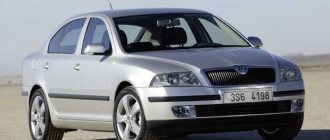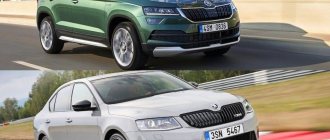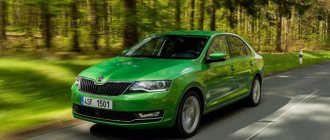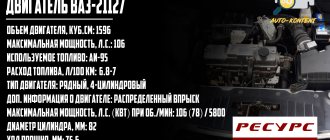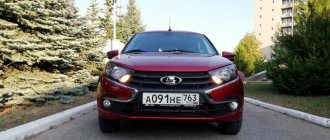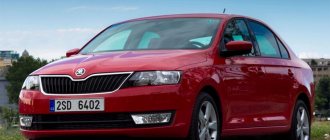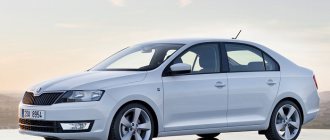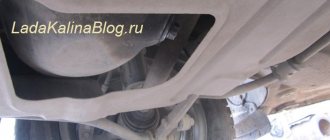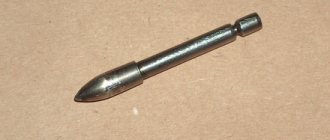The history of the Skoda Octavia begins back in 1959, when the line was represented by compact economy hatchbacks. Much water has passed under the bridge since then - the collapse of Czechoslovakia, the formation of the Eurozone, the strict standardization of all automakers to international standards. Octavia has evolved significantly, and eventually became a real bestseller in the European Union, CIS, and Asia.
The huge demand is justified by the highest build quality, not inferior to German, reliability of the components, and all this at an affordable cost. The Octavia A5 FL is also attractive because it looks no worse, and maybe better, than D-class sedans, for example, Volkswagen Passat, Audi A4. The price of the model on the secondary market is from 500 thousand rubles.
- The Skoda Octavia A5 is built on the basis of the PQ35; all cars of the family produced since 2009 have received the FL prefix.
Engines
The Skoda Octavia A5 was equipped with both petrol and diesel units. Gasoline engines are traditionally the most popular in the CIS countries. The reason for this is additives in fuel and low temperatures. However, Octavia diesel engines are famous for their unpretentiousness to the quality of diesel fuel, which cannot be said about competitors from the “Big Three”: Audi, Mercedes, BMW.
Petrol Octavia A5 FL:
- 4TSI is the smallest and most economical Skoda Octavia. But not the weakest. Turbocharging provides sufficient thrust throughout almost the entire rev range. Power – 122 hp. Consumption in the city is about 9 liters per 100 kilometers. Acceleration to 100 km/h – 9.7 seconds.
- 6 MPI/75kW – the most affordable configuration. 102 horsepower, 10.5 liters of consumption in the urban cycle. This engine could be equipped with a six-speed automatic transmission with a classic torque converter - 6AG. This engine has never been particularly popular, since it does not provide the required level of acceleration with quite serious fuel consumption.
- 8 TSI/118kW is a turbocharged engine with the best combination of acceleration/dynamics in the line. Power 160 hp enough to confidently overtake, to change lanes in a metropolis. Consumption in the city is only 9.5 liters per hundred.
Diesel Skoda:
- 0 TDI CR/103kW DSG is the most powerful turbodiesel installed on the Skoda Octavia A5 FL. With minimal fuel consumption, 6.5 liters in the city, it provides sufficient dynamics both in the metropolis and on highways.
- 1.9TDI-PD/77kW is the most economical engine available for the Skoda Octavia A5 FL. Consumption in the urban cycle is 6 liters. Power – 105 horsepower.
Transmission
The car was equipped with all-wheel drive and front-wheel drive. The Skoda Octavia A5 FL 4x4 was equipped with a Haldex transfer clutch, which has long proven itself to be the best. Intelligent all-wheel drive, depending on the road surface, can provide up to 86% of torque to any of the wheels and up to 90% to the rear axle.
The consumer has a choice of four gearboxes - six and five-speed manual or DSG-6, DSG-7 and AG. The preselective automatic reduces consumption by 10 - 15%, but fans of VW cars do not speak well of the seven-speed robot, which cannot be said about the DSG-6, which uses a progressive double-disc wet clutch. The “dry” DSG-7 does not use oil, is the most technologically advanced gearbox of the concern, has record efficiency, but is not designed to operate at high speeds - replacing the unit will cost 2.5–3 thousand dollars.
VW has made technology from Formula 1 racing available to everyone. The DSG gear shift speed does not exceed 8 milliseconds, which is three times faster than standard automatic transmissions. These are excellent dynamics, reduced consumption, the ability to change gears yourself - switch to manual mode. Among the disadvantages, it is worth noting the expensive procedure for changing the oil, but it is usually carried out no more than 60 thousand kilometers. Later, the preselective automatic machine appeared in Mitsubishi and some other “popular” brands.
A five-speed manual transmission is available for all Skoda Octavia A5 FL engines, except for the two-liter turbodiesel and 1.8 TSI. The six-speed was installed only on the 1.8 TSI; this engine was also equipped with DSG-7.
Differences between Skoda Octavia A5 restyling and pre-restyling
According to performance characteristics
Traditionally, we will focus on the technical characteristics of the updated version. As is clear from the index, the restyling of the Skoda A5 is assembled on the same “Vagov” PQ-35 platform on which the first version of the 2nd generation was assembled. And this indicates the presence of:
- independent suspension front and rear (MacPherson struts + multi-link system);
- disc brakes on both axles (front with ventilation);
- front-wheel drive for the basic version and all-wheel drive (Haldex clutch) for the Combi off-road version;
- manual parking brake.
But then there are differences. Instead of power steering, they offered electric power steering. The 5-speed manual transmission and 6-automatic transmission remained in place, but the 6-DSG “robot” evolved into the 7-DSG. Also, during the restyling of the Octavia A5, many changes were made to the engine range.
Now she looked like this:
| engine's type | Designation | Volume, l. | Power, hp | Hmm | Consumption, l./100 km (mixed) | Acceleration to 100 km/h, sec | Max. speed, km/h |
| MPI | CGGA | 1.4 | 80 | 132 | 7,0 | 14.2 | 173 |
| TSI | CAXA | 1.4 | 122 | 200 | 6,3 | 9.7 | 203 |
| MPI | BGU | 1.6 | 102 | 148 | 7,9 | 14.1 | 184 |
| TSI | CDAB | 1.8 | 152 | 250 | 6,9 | 8.1 | 219 |
| TSI | CCZA | 2.0 | 200 | 280 | 7,7 | 7.2 | 240 |
| TDI | BKD | 2.0 | 140 | 320 | 5,4 | 9.7 | 208 |
Photo of Skoda Octavia A5 restyling in metallic color
For comparison, the predecessor does not have a 1.4 TSI, but there were 2.0 FSI with 150 hp, 1.9 TDI with 105 hp. and 1.6 FSI with 116 hp, and the presented 1.8 TSI had 160 hp, not 152.
Read also General information about cars of the Skoda Octavia Scout line
Also, the restyling of the Skoda A5 made adjustments to the RS and Scout modifications. The latter was brought directly from the Czech Republic with a 1.8 TSI with 152 hp. (instead of 2.0 TSI with 150 hp). By the way, all-wheel drive is now only available on the off-road Combi. Other versions are cut.
As for the RS, the engine was left untouched, but the 5-speed manual transmission was replaced with a 6-DSG (although the standard version was already equipped with a 7-DSG). The loss in dynamics is only 0.1 sec. By the way, in the 3rd generation the Skoda people came to their senses and offered both boxes.
In addition, the Ereska was offered with a sports suspension, a stiffer stabilization system, six-piston reinforced calipers, a 10 mm lower ground clearance, an electronically adjustable exhaust and three driving modes (Normal, Comfort and Sport).
Under the hood of the Skoda Octavia A5 restyling
By appearance
Separately, it is worth highlighting the visual of the Skoda Octavia A5 restyling. Perhaps this was the most radical change in the entire history of the model (except for the 4th generation). The manufacturer also emphasizes the new appearance with an additional “” nameplate, which means “FaceLifting”.
It is noteworthy that upon closer examination there are not so many changes: the optics moved away from rectangular shapes towards the “drop” side, the front fenders were slightly changed, the grille received a different filling and a wider chrome molding in the upper part, and the bumper was slightly adjusted at the bottom.
Skoda Octavia A5 restyling in white
Otherwise, the restyling of the Skoda Octavia 5 does not offer anything new. Except for new alloy wheels and body enamel options. The dimensions of the car also remained the same:
| Length, mm | Width, mm | Height, mm | Wheelbase, mm | Ground clearance, mm |
| 4597 | 1769 | 1447 | 2578 | 164 |
The RS and Scout versions have ground clearance of 154 and 179 mm, respectively.
As for the interior space, the restyling went tangentially. Paying tribute to the times, a multifunction steering wheel, a new dashboard design and an LCD screen on the center console have appeared in the arsenal.
Photos of the Skoda Octavia A5 restyling interior
Body
The Skoda Octavia A5 FL was produced in liftback and station wagon body styles. Among the advantages stand out: a spacious trunk, ground clearance, anti-corrosion protection. High ground clearance has become a help for many car owners - the Skoda Octavia A5 FL is often lowered by cutting springs and so on. But in the conditions of the Russian outback, where there are problems with roads, 165 millimeters is a very decent indicator.
The luggage compartment volume is 560 liters, which allows you to easily fit a folded stroller or even a bicycle. A distinctive feature of the liftback body is the trunk lid, which opens along with the rear window. This design allows you to fold large items. Five people of average configuration can fit inside without hesitation.
- Dimensions of Skoda Octavia A 5 FL : length – 4569 mm, width – 2018, height – 1462, wheelbase – 2578.
Curb weight (filled, without passengers or cargo) is 1265, gross weight is 1925. The turning circle is no more than 10.5 meters - this is a relevant and acceptable indicator for maneuvering in urban conditions.
Skoda Octavia II generation A5 (2004-2013)
Several C-Class models are built on the fifth-generation Volkswagen Golf platform, including the premium Audi A3, as well as the exquisite Seat Altea.
However, of greater interest in the automotive market is the Czech carrier of the German base - Skoda Octavia, distinguished by its popularity, adaptability to everyday use and, most importantly, reasonable price.
It’s not without reason that they say that those who bought a Skoda cleverly deceived everyone by getting the same Audi, only cheaper. Maybe there is some truth in this, but Czech cars carry other values. For example, the heroine of our review is loved for her “family” characteristics. For many, this car has become almost the only candidate from the golf class, vying for the position of a lightweight, super-capacious, practical carrier of passengers and cargo.
This is not surprising, because due to its size, the Octavia, presented in liftback and station wagon bodies, managed to push some participants in the D segment.
With the release of the third generation, the second generation of the model, produced since 2004 and undergoing restyling in 2009, completely migrated to the Second Hand market. That is, to the place where real strength tests take place. Different climatic and road conditions, different driving styles of owners and frequency of operation. It's time to take stock. Let's say right away that the Czechs once again did not have to blush for their creation. Even after several years of operation, Octavia saves the owners’ money. But there are no perfect cars; even champions have weaknesses.
The units for the Czech model were the same as those from the steadily developing German concern. The 75-horsepower 1.4 engine looks like a real outsider in all the variety of engines. But it is an outsider only in terms of traction characteristics, since it does not cause much trouble in operation. For example, more modern “supercharging” installations were repaired much more often.
The 1.8 TSI turned out to be the most annoying, preferring to be powered not only by gasoline, but also by oil. What a shame it was for some owners to have to give up a completely new car to replace a worn-out piston group. However, the most common “disease” is oil fogging of the turbine pipe. It’s not such a terrible phenomenon as a “capital leak,” but there’s not much pleasure in repairing such parts either.
The 2-liter FSI looks like a good boy in this regard, as it was only noted for premature wear of the timing belt. It is better to install a new “consumable” every 60 thousand km, so as not to “get” something more expensive.
Unit 1.6 with 102 liters. With. turned out to be the most popular. Fortunately for Octavia lovers, it is the leader in reliability. Of the systematic malfunctions, only “glitches” of the throttle valve were noted here. If you do not have increased requirements for dynamics, then when choosing a used car, we recommend considering this particular modification, or getting a version with a 1.9-liter diesel engine. For 2-liter TDIs, there have been cases where the cylinder head has been replaced.
For owners of belt engines, servicemen have one useful piece of advice: install a new pump during every second timing drive replacement.
We have written more than once about the imperfections of existing robotic gearboxes. About DSG as well. Skoda Octavia is no different from all the others. Here, too, the fastidiousness of the transmission is expressed in the need for adaptations, early clutch replacements and the sensitivity of the mechatronics.
You can put off trouble by driving carefully, excluding parking with the brakes on, and using manual mode. In the event of a breakdown, dealers install an upgraded clutch that can last longer. However, these terms will be far from the viability indicators of the clutches of a conventional mechanical transmission.
At the same time, manual transmission owners, albeit occasionally, still come to the service center to replace shaft bearings, but a regular “automatic” has no systematic “diseases” at all. In the suspension, the bushings and struts of the rear stabilizer are the first to “die” - 70-80 thousand .km. The same parts, but in the front part, as a rule, last longer - 110-130 thousand. However, at such a mileage it is usually time to replace the silent blocks of the front control arms.
Apart from cases of early bearing failure (up to 100 thousand km), in general terms the rear chassis is quite durable, but, unlike its predecessor, where a beam was used in the stern suspension design, the second generation Octavia requires periodic adjustment of the wheel camber angles.
The multi-link system gave the liftback not only a balance of comfort and handling, but also additional costs during many years of using the car. You understand how repairs can turn out for a prudent summer resident and family man when the elastic elements of the chassis have outlived their useful life.
The entire steering chain from the steering wheel and electric power steering to the very tips showed itself to be very worthy in operation. The latter sometimes “walk 150-200 thousand km, beating many competitors.
The Octavia salon is a role model. The interior has earned the respect of car enthusiasts not only for its size and practicality, but also for its decent quality. Not that there are breakdowns - even squeaks are rare here. If any sounds do appear, their source, as a rule, is located somewhere in the rear. The most “terrible” failure case is attributed to the seat belt indicators.
The outer part of the body is also vying for a medal. This is especially true for the metal itself and the paintwork. True, the chances of winning the top award are undermined by a couple of little things – the rear door molding coming off and the seals rubbing off the paint. Fortunately, the last drawback did not appear on restyled cars.
Electronics cope well with salty Russian roads. True, some owners complained about the failure of daytime running lights and rear wiper due to oxidized contacts. The next incident is much less common, but attracts more attention. And it refers not to reagents, but to real mysticism. Otherwise, it is difficult to explain what kind of entity rolls down the door windows on the move. Although most likely the basis of the “miracles” is either a “glitch” of the electronics, or the carelessness of the owner or passengers.
For the second generation Skoda Octavia, the question is “is it worth it?” not clear. This car is practical, attractive, comfortable, well equipped and, as we found out, quite reliable. It seems worth it, but how much? Having stumbled upon the price, you begin to remember all his “sins”. If you really need this car, then candidates with a “robot”, problematic engines and high mileage should immediately be removed from the list. It’s a good idea to check the “chosen one” for accidents and criminal history.
Bottom line
Along the way, you will need to resolve many issues and think through different options. After all, this is one of those cars that are bought by prudent family people who choose wisely, wanting to know exactly what they are paying that kind of money for. The choice of the majority, as a rule, falls on the version with the 1.6 engine and manual transmission.
Design
The Skoda Octavia A5 FL remains recognizable from the side; the front and rear parts are very similar to the Superb business sedan - a massive radiator grille, elongated headlights, the car has become noticeably wider. The “stern” has evolved insignificantly compared to the A4, but is made in a modern interpretation. The shapes have become more streamlined, which significantly improves the aerodynamic drag index.
Skoda's side mirrors are equipped with turn signal indicators. Head optics are available with both halogen lamps and xenon arcs. Intelligent fog lights were optionally installed to illuminate the turning path. The side mirrors remain large and very informative - Skoda engineers give preference to safety and comfort, ignoring newfangled trends in the field of automotive design.
There are several shades of white, black, red, green and gray available to choose from. The surcharge for metallic was an average of $600. What is noteworthy is that alloy wheels were installed in the base.
Suspension
The Octavia's chassis never causes any complaints - the car reacts sharply and predictably on any surface. Gas-oil shock absorbers with springs provide good handling on turns. The front has a traditional MacPherson strut with wishbones, and the rear has an independent multi-link suspension.
Driving on uneven surfaces does not cause discomfort; the car behaves collectedly, guaranteeing smoothness and softness. The Skoda Octavia A5 FL is well balanced between comfort on the dirt road and handling on the asphalt.
Roll in corners is minimal. Ventilated disc brakes are installed at the front, non-ventilated at the rear.
Options
Laurin & Klement is traditionally the most expensive equipment in the Skoda Octavia family. This is leather upholstery of seats, gearbox handles, door cards. The front panel is decorated with wood-look inserts. The upholstery options for the seats, passenger and driver, are incredibly varied - suede, perforated leather, different colors of stitching, and so on. It’s worth noting that the wood-effect inserts don’t look like grandma’s sideboard; they, “Volkswagen style,” neatly and laconically decorate the interior with subtle accents on the door panels and panels.
The main differences of the Ambition + package are the Jumbo Box compartment for small items under the front armrest, which also contains an audio jack for connecting a smartphone, a four-spoke steering wheel trimmed in leather, fifteen-inch PYXIS alloy wheels, front fog lights.
Elegance equipment package – dual-zone Climatronic air conditioning system with electrical control, Jumbo Box, heated front seats, rear parking sensors, four-spoke multi-steering wheel with controls for the standard audio system, visual interface for controlling MAXI DOT systems, sixteen-inch PROXIMA alloy wheels.
Five with a minus: what is wrong with the previous Skoda Octavia?
Exactly eight years ago, we summarized that the first generation Skoda Octavia A4 is good in terms of reliability. Didn’t its successor on the A5 platform, produced from 2004 to 2013, disgrace family traditions?
The global platform A5 (PQ35) unites the Skoda Octavia with the Volkswagen Golf and Jetta fifth series, Touran, Tiguan, Eos and Golf Plus, Seat Leon, Altea and Toledo, and even with the Audi A3 and Audi TT of the second generation
Heredity - in all its glory. This is about the Octavia body: Volkswagen cars have long had no problems with the ability to resist corrosion, and Skoda is another confirmation of this (handicraft repaired cars do not count).
Before the 2008 restyling, the appearance was more angular - with different headlights and taillights, a hood, and a different dashboard in the cabin. But the main thing is that the range of engines has seriously changed
And, alas, just as traditionally, paintwork does not always manage to tenaciously hold on to well-galvanized metal: if chips are not touched up in time, ulcers can develop, leaving bald spots on the hood, sills, wheel arches and the bottom of the doors.
It is better to touch up chipped paint without delay - so as not to grow
In pre-restyling cars older than 2008, the paint also suffers from bad door seals, and peeling door moldings and cloudy headlights often add to the tired look. The contacts in the license plate lights, which are poorly protected from moisture (10 euros each at the rate of 63 rubles per euro), sometimes rot in just two to three years, and due to the failure of the switch under the brake pedal (15 euros), the brake lights stop working.
The “chrome” finish loses its luster after five to six years - fortunately there are minimal decorative elements with it
After five or six years, did the power window control unit, central locking, drives and heated exterior mirrors begin to malfunction or completely fail? This ailment is also familiar to the owners of many Volkswagens - first of all, check the serviceability of the wiring between the driver's door and the body pillar: the harness breaks at the bend (the wiring became more reliable only in 2011).
The windshield wiper mechanism can fail after 100 thousand kilometers
Octavia also suffered from a host of other corporate ills. In pre-restyling models, the head unit of the audio system is often capricious (500 euros). Regardless of the year of manufacture, the microswitches built into door locks (150 euros each) are rather weak - and the control unit does not see the opening and closing of the door. The trapezoid of the wipers (200 euros) is rather weak, and you need to be prepared for wear after 100 thousand kilometers, and for versions with a windshield wiper on the trunk lid, this too is at risk.
The interior is assembled with high quality and begins to creak only after driving well over 100 thousand kilometers. And the most obvious signs of age are the polished steering wheel and gear knob and the worn fabric of the armrests on the door trim.
The interior is assembled with high quality and begins to creak only after driving well over 100 thousand kilometers. And the most obvious signs of age are the polished steering wheel and gear knob and the worn fabric of the armrests on the door trim.
0 / 0
After 60-80 thousand kilometers, the climate system fan motor (100 euros) is also capable of squealing in the same trademark Zhiguli way - lubricant, as a rule, does not save for long, fortunately craftsmen have long gotten used to changing only the bearings. The design of the unit was, alas, finalized only at the end of the production of the “second” Octavia in 2012.
For versions with Climatronic automatic climate control, after three to five years, the weather in the house can be spoiled by both the damper drives and the unit itself. It happens that in the fifth year of life, microcracks appear in the air conditioner evaporator, and the compressor of the first three years of production is not reliable (300 euros). And in winter, be sure to get into the good habit of shaking snow off your shoes before getting behind the wheel - otherwise, if a large amount of ice accumulates, the plastic hinge of the floor gas pedal (100 euros) may simply fall apart.
What about power units?
We had a lot of diesel copies that arrived from Europe (less than 3% of all modifications in total), but it’s a pity: they are not bad, although not without sin. The main blemish on the reputation of the two-liter diesel engine with a common rail power system on Octavias no older than 2010 (1.5% of offers) was cracking of fuel lines due to defective materials on copies of the first year of production, which led to a service campaign at the end of 2011 for their replacement. It happens that the valve cover seal leaks, the USR valve becomes clogged from short trips and fidgeting in traffic jams (280 euros), and with a mileage of 110-130 thousand, the intake manifold and water pump were replaced (170 euros for the original and from 50 for analogues). But usually concerns with this engine come down to replacing the injector seals after 100-120 thousand kilometers (15 euros per set).
The full version is available only to subscribersSubscribe now
I'm already subscribed
Safety
In Euro NCAP tests, the Skoda Octavia received the highest ratings - five stars and 27 points in the classification for passenger and driver protection, 37 for child protection in the cabin. The car cares less about pedestrians – only 17 points. This is facilitated by the proper level of active and passive safety - electronic systems and body rigidity.
The interior is equipped with universal mountings for child seats, seat belts in the rear and front seats, and active head restraints as an option.
Electronic security systems for Skoda Octavia:
- ABS – anti-lock braking system.
- EBD – brake force distribution system.
- ESP – exchange rate stability system.
- Traction control, ASR – traction control system.
- MSR – engine braking control system.
- Child seat attachment.
Advantages and disadvantages of Skoda Octavia A5 restyling
Restyling is, in essence, working on the mistakes that were made when designing the original and a good tool for stimulating sales before the release of the new generation. However, in the budget segment, in order to maintain a competitive price tag, many comments remain unheeded.
Read also Skoda Octavia in Active configuration: review of reliable and modern cars
This was not fixed:
- sound insulation - the cabin is still quite noisy;
- the dynamics of the 102-horsepower MPI, with which the Octavia simply does not go;
- weak optics, due to which you constantly have to turn on the fog lights;
- stabilizer struts, which still die every 100,000 km;
- hard seat padding;
- a stove that never heats up at idle;
- Plus, all-wheel drive trim levels have been cut again.
On the positive side: the new “robot” no longer spoils the clutch, the engines no longer suffer from oil burns, the suspension has become softer without compromising reliability. Well, the appearance has become more friendly.
Skoda Octavia A5 restyling (rear view)
